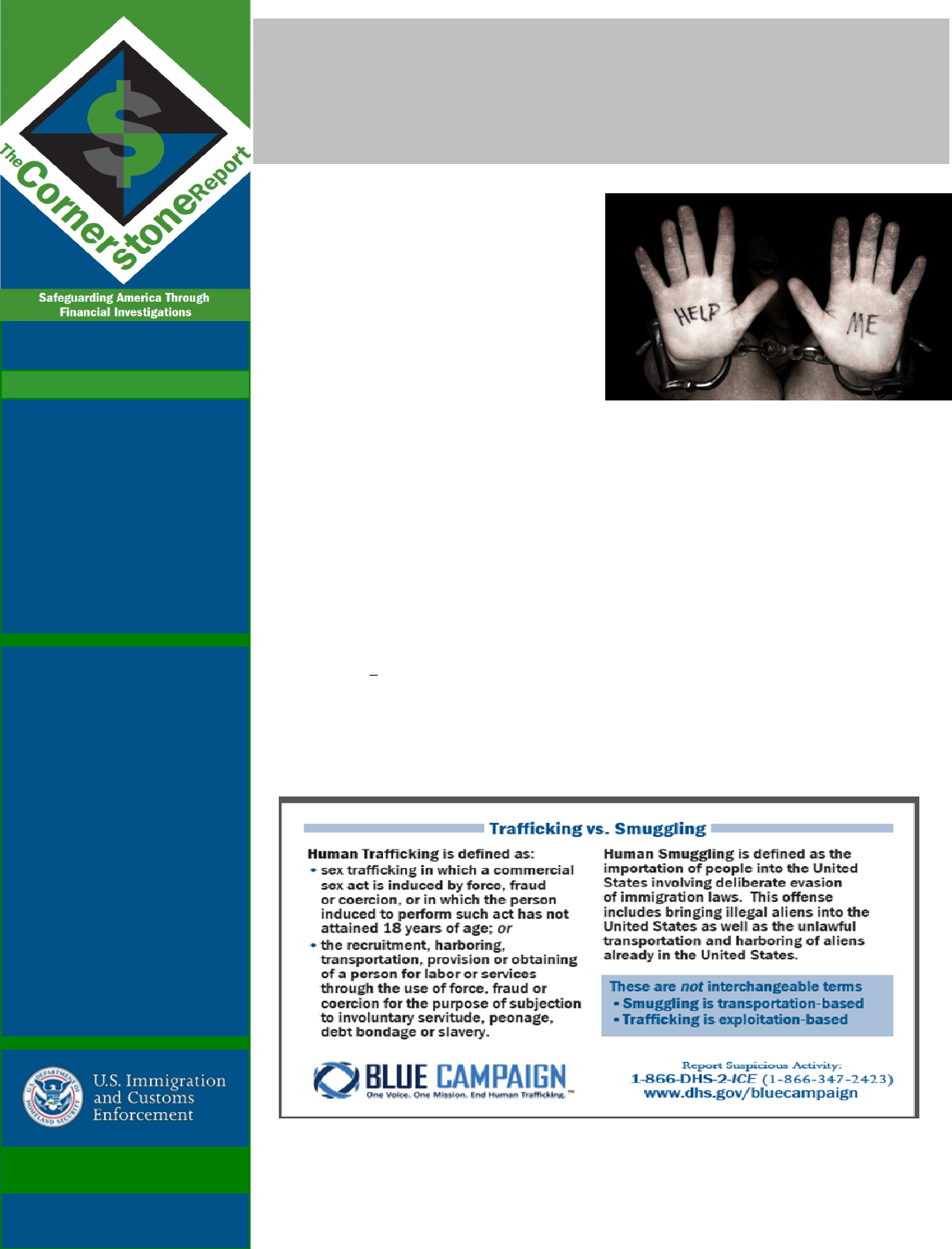
Please feel free to send your questions and comments
to the editors of the Cornerstone Report at: [email protected]
For Project Stamp and case studies: www.ice.gov/stamp
V O L U M E X I I I : N O . 1 — S U M M E R 2 0 1 7
H
uman tracking and human
smuggling are often confused.
The two crimes are very dierent and
it is critical to understand the
dierence between the two.
Human tracking involves
exploiting men, women, or children
for the purposes of forced labor or
commercial sexual exploitation.
Human smuggling involves the
provision of a service—typically,
transportation or fraudulent
documents—to an individual who
voluntarily seeks to gain illegal entry
into a foreign country.
It is possible the crime may start out
as human smuggling but quickly turn
into human tracking. U.S.
Immigrations and Customs
Enforcement (ICE) Homeland
Security Investigations (HSI) is the
lead agency countering both issues.
HSI exploits the nancial
vulnerabilities of smuggling and
tracking organizations to stop their
illegal activities.
If you think you have witnessed
tracking and/or smuggling activity,
please call HSI at:
1-202-312-9746
Or
1-800-BE-ALERT
Volume XIII No. 1 Summer 2017
Inside This Issue
Human Tracking vs
Human Smuggling….……………..1
Red Flags……………………………….2
Cornerstone is U.S.
Immigration and Customs
Enforcement’s (ICE)
comprehensive investigative
initiative for ghting nancial
crime.
The Cornerstone Report is a
quarterly bulletin
highlighting key issues related
to ICE Homeland Security
Investigations’ (HSI) nancial,
narcotics and special
operations investigations.
Toll Free Tip Line:
1-866-DHS-2-ICE
www.ice.gov/cornerstone
Human Tracking vs
Human Smuggling

Common Human Tracking business
fronts: Modeling and travel agencies,
employment companies, “au pair”
babysitting and international
matchmaking services (mail order bride),
massage parlors
Transactions conducted by individuals, escorted by a
third party (under the pretext of requiring an
interpreter), to transfer funds to other countries
Frequent transactions, inconsistent with expected
activity or line of business, carried out by a business
customer in apparent eorts to provide sustenance to
individuals such as: payment for housing/lodging,
regular vehicle rentals, purchases of large amounts of
food, frequents purchases at pharmacies (e.g. medicine/
condoms for victims)
Payment to employment or student recruitment agencies
that are not licensed/registered or that have labor
violations
Frequent payments to online escort services for
advertising, including small posting fees to companies of
online classieds as well as more expensive high-end
advertising and website hosting companies
Accounts of foreign workers or students where the
employer or employment agency serves as a custodian
Business owner does not exhibit normal payroll
expenditures such as wages, payroll taxes, social security
contributions. Payroll costs can be non-existent or
extremely low for the size of the customer’s alleged
operations, workforce or business model.
Multiple accounts established for dierent businesses or
persons with the same signatory powers on each account
Frequent outbound wire transfers with no business or
apparent lawful purpose, directed to countries at higher
risk for human tracking or to countries that are
inconsistent with the customers expected activity
Business bank accounts that lack typical business
expenses or account activity does not relate to the
business
Credit or debit processing for even dollar amounts, or
transactions at time when atypical for business type (e.g.
2 am transactions)
Leasing of high-end luxury vehicles and extravagant trips
paid by electronic funds transfers from business bank
accounts
Receipt of numerous incoming wire transfers or personal
checks inconsistent with account type
Wire transfers from one business account to another
business account that has no apparent ties
Checks deposited from a possible funnel account appear
to be pre-signed, bearing dierent handwriting in the
signature and payee elds
Frequent exchange of small denomination bills for larger
denomination bills by a customer who is not in a cash
intensive industry
Sudden increases in cash deposits, rapid turnover of
funds and large volumes of cash deposits from unknown
sources
Money ows that do not t common remittance patterns
such as wire transfers that originate from countries with
high migrant populations (Mexico, El Salvador,
Honduras, Guatemala) directed to beneciaries location
in US or Mexican cities along the border
Beneciaries receiving wire transfers from countries with
high migrant populations who are not nationals of those
countries
Inows are largely received in cash where substantial
cash receipts are inconsistent with the customers line of
business
Wire senders may use similar transactional information,
including commons accounts, addresses, phone numbers
and IP addresses
Multiple wire transfers to the same beneciary who may
be located in the US or Mexican city along the SW border
When questioned, the senders have no explanation for
the purpose of the wire transfer and have no relation to
the recipient of the funds
New accounts that often reect similar activity of that of
the closed account
Page 2 of 2
Volume XIII No 1
HS/HT Red Flag Indicators
HSI – A Diverse, Global Force
HSI is a critical investigative arm of the Department of
Homeland Security and is a vital U.S. asset in combating
criminal organizations illegally exploiting America's
travel, trade, nancial and immigration systems.
DHS/ ICE
Homeland Security Investigations
500 12th Street, SW
Washington, DC 20536
Web: www.ice.gov
